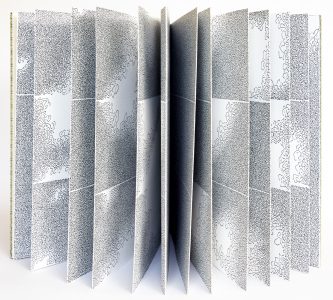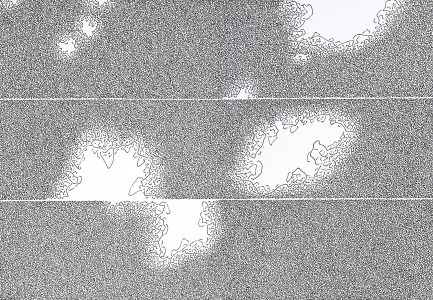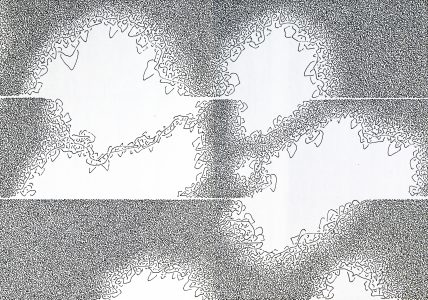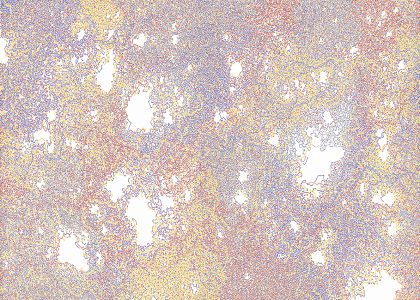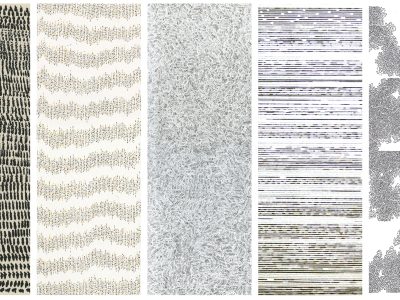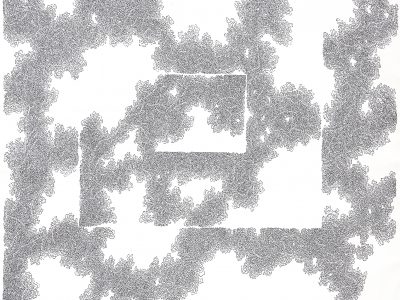Frank
Vigneron
Frank VIGNERON, Chair & Professor, Department of Fine Arts
Hong Kong (China), 1965, lives and works in Hong Kong.
Born in a traveling French family (his father worked for an international shipping company), Frank Vigneron was born in Hong Kong and grew up in Vietnam, Belgium and then France before returning to Hong Kong in 1990.
He has always practiced drawing as a self-taught artist without taking art classes, preferring to study art history and China studies. After obtaining an MPhil at INALCO in Paris (with François Cheng as his supervisor), he has taught French as a foreign language at Alliance Française de Hong Kong without interrupting his artistic practice. After obtaining his first PhD in Far Eastern Studies at Paris VII Denis Diderot, on an 18th-century Chinese painter and theorist, he began exhibiting his works in Hong Kong, China and, from time to time, Europe.
In 2004, he started teaching art history at the Chinese University of Hong Kong in the Department of Fine Arts of which he is now the chairperson, while continuing his studies. He obtained a Doctorate of Fine Arts at the Royal Melbourne Institute of Technology in Australia and a PhD in Comparative Literature at Paris IV Sorbonne (a comparative study of art theory in China and Europe in the 18th century). While writing extensively on the local contemporary art scene of Hong Kong and its developments, he has never ceased to publish on the art theory of China, taking a close look at a reflexion that has always informed his own art practice.
Since the beginning of his artistic work, taken the collective title of Le Songe Creux (a project that was initiated in Paris in the 1980s), he has conceived it as a writing process since he traces these lines with a pen on a table. Even though the evocation of a monk copying has always been present in his mind, it is in the Chinese world that more fruitful comparisons with his work can be found. The long hours spent tracing these intertwined lines are as much tied to the notion of Kungfu (gongfu 功夫, which was, before meaning the Chinese martial arts, simply meant the time spent perfecting a skill, whichever it is) as the materialisation of notions borrowed from the Chinese theory of art. It is the concepts of ‘empty’ and ‘full’ that animate the relations of forms manifested in the drawings of Frank Vigneron. Other notions from that theory of art are also operating in his work and have been analysed in publications such as articles in academic journals or art publications self-published by the artist.
Le Songe Creux – disappearance as a project
Frank Vigneron
Le Songe Creux (which is an expression meaning ‘a daydreamer,’ but can literally be translated as ‘The Hollow Dream’) as a project is rooted in a desire for self-effacement and the final disappearance of the artwork itself within its own complexity, the accumulations of lines very often leading to a complete ‘all-over’ painting where these lines tend to become invisible and eventually flatten the image into a state of quasi disappearance. This attitude transpires in Le Songe Creux as a certain blandness that is, in fact, actively pursued. Because of these drawings’ compactness and paleness, most viewers are not immediately attracted to them, but the delay thus imposed on the actual viewing experience often works in favour of the artworks.
Le Songe Creux was not conceived within the framework of Platonist idealism, and there is nothing ‘behind’ the painting as in the Minimalist tradition. In that sense, it is important to emphasize how much my academic research in the painting theory of the Chinese literati has informed my art practice (supported, obviously, by the works of François Cheng and François Jullien). It is especially the understanding of the concept of ‘void’ (kong 空 or xu 虛), a concept formulated in the philosophy called ‘neo-Confucian,’ that has underpinned the making of these drawings. To understand better how the ‘void’ takes on an ontological role in Chinese painting, we have to turn to landscape painting, the highest genre practiced by the Chinese literati. The word ‘landscape’ in Chinese painting is rendered by the binomial ‘mountain-water’ (shanshui 山水), stating very clearly that Chinese landscape paintings are constructed with these two elements while trying to organize them within a monistic conception of the universe. When we look at landscapes made by literati painters, especially those made in monochrome ink, we can see that the relation between the mountain and the water, thanks to the void the artist instils between the two, removes any difference between subject and object. The void, most of the time depicted as fog, links them up, and, at the same time, removes any differentiation: a cloud is as much a rock by its shape as it is water by its composition and thus blurs their respective limits, mixing mountain and water into an undifferentiated whole.
For many neo-Confucian art theorists in pre-Republican China, the practice of landscape painting was a way to enter a nature that was also contained within themselves. For them, it was only after having mastered the basic techniques of the ‘brush-ink’ (bimo 筆墨) that one could follow the sudden ‘triggering’ of creative desire (ji 機). This moment lead then to ‘transformations’ (bian 變), i.e. both the personal inventions of the artist and their constant adapting to the events of the creative act. One of these theorists insisted on the fact that these acts took place ‘between the intentional and the non-intentional’ (youyi wuyi zhijian 有意無意之間). These ‘transformations’ were themselves created within the ‘heart cavity’ (xinkan 心坎, which means a person’s conscience in Chinese and has nothing to do with the sentimentality attached to the concept of ‘heart’ in most Western languages) in relation with the ‘power of metamorphosis’ of nature (zaohua 造化). To simplify, it can be said that nature finds itself in the mind of the artists who are themselves contained by nature, they are thus able to contain and be contained at the same time by the whole universe.
Even though Chinese literati painters were also preoccupied with the quest for personal styles, they only saw them as the logical results of these ‘transformations,’ unavoidable and therefore clearly desirable. The undifferentiation of subject and object in landscape painting lead literati painters to make themselves absent from their own paintings, in order to let the universe manifest itself unencumbered. Even the word for ‘nature’ in Chinese is expressed by the characters daziran (大自然) which means literally ‘great spontaneity,’ thus clarifying that ‘nature’ realises itself fully in a constant and self-generated way. Faithfulness to this process of self-generation is only possible through an effort at self-effacement made by the painter. In the entire body of literati painting theory, one can find the repeated idea that artists need to make a sustained effort of reflection and meditation to accomplish this process and that only artists with a strong personality can do so. This is also true of the people viewing the paintings: they will be capable of perceiving nature expressing itself in these paintings only by effacing themselves in the process of perception. It is in the void/hollows of Le Songe Creux that we will efface each other.
Some bibliographical indications:
Art books:
– Le Songe Creux – Codex, Hong Kong : MCCM Creations 2008.
– Le Songe Creux – Heterotopias, Hong Kong: Hong Kong Arts Development Council, 2006.
Academic publications:
– China Pluperfect I. Epistemology of Past and Outside in Chinese Art, Hong Kong: The Chinese University Press, 2022.
– China Pluperfect II. Practices of Past and Outside in Chinese Art, Hong Kong: The Chinese University Press, 2022.
– Hong Kong Soft Power. Art Practices in the Special Administrative Region 2005 to 2014, Hong Kong: The Chinese University Press, 2018.
– I Like Hong Kong… Art and Deterritorialization, Hong Kong: The Chinese University Press, 2010.
– Académiciens et Lettrés. Analyse comparative de la théorie picturale du 18e siècle en Chine et en Europe, Paris: Editions You Feng, 2010.
Solo exhibitions:
‘Le Songe Creux,’ at 敬一书院 (杭州弧山一片云文化藝術中心), West Lake, Hangzhou, China. 13 October to 12 December 2019.
‘Le Songe Creux,’ organized by Lucie Chang Gallery, Art Central, Hong Kong, 27-31 March 2017.
‘Le Songe Creux,’ exhibition at ODRADEK, Brussels, Belgium, 10 March – 10 April 2017.
‘Le Songe Creux’, at Lucie Chang Fine Arts, Hong Kong. 26 May to 26 July 2016.
‘Le Songe Creux,’ Le Pont des Arts Gallery, Shanghai, 2011.
‘Le Songe Creux,’ MOCA China, Delay No Mall, Hong Kong, 2008.
‘Le Songe Creux,’ Invitational Exhibition, during the Graduation Show of the Fine Arts department. Hui Gallery, Sheng Ming Building, the Chinese University of Hong Kong, May-June 2005.
‘Le Songe Creux,’ Hong Kong Institute of Education, Hong Kong, 2005.
‘Le Songe Creux,’ Baptist University, during the French Festival. 08 to 19/03/2004. Wo Foo Foundation Amelia Lee Student Centre, Student Common Room. With a master class, ‘Le Songe Creux – Writing within the Blanks’, 15/03/2004.
‘Le Songe Creux,’ John Batten / Gallery, Hong Kong, 2004.
Le Songe Creux. John Batten / Gallery, Hong Kong, 2003.
Le Songe Creux / The Hollow Dream. John Batten / Gallery, Hong Kong, 1999.
‘Le Songe Creux,’ Hong Kong Institute of Education, Hong Kong, 1998.
‘Le Songe Creux,’ organized by John Batten / Gallery, Hong Kong Country Club, Hong Kong,
‘Le Songe Creux,’ Fringe Club, Hong Kong, 1997.
Group exhibitions:
‘Writing Non-Writing: 2019 Hangzhou International Contemporary Calligraphy Festival’ (書非書: 2019 杭州國際現代書法藝術節), 12 to 24 October 2019, Art Museum of China Academy of Art (218 Nanshan Road, Hangzhou, Zhejiang, China) 中國美術學院美術館(浙江省杭州市南山路218 號).
Ink Brussels 2019. Advanced Research in Ink Art. 6-12 May 2019. Espace d’Architecture (Faculté d’Architecture, La Cambre Horta, 19 Place Flagey, Brussels, Belgium), Curatorial team: Kiran Katara, Lia Wei, Zhang Qiang, Simone Schuiten.
Frank Vigneron, Ho Siu Kee (韋一空,何兆基), Le Songe Creux + Mountain and Sea Series (想虛空+ 山水系列), curator: Frank Yang 楊鋒. Overseas Chinese Town (OCT) Boxes Museum (華僑城盒子美術館), Shunde 順德, Guangzhou 廣州, China. 10 August – 17 September 2018.
2017 Bi-City Biennale of Urbanism/Architecture (Shenzhen) 深港城市建築雙城雙年展(深圳), Luo Hu Sub-Venue 羅湖分展場, Shenzhen Industrial Station深圳工業站, 19 December 2017 – 15 March 2018.
Borrowed People, Curator, Francis Yu 余偉聯, 18 November-1 December 2017, AVA, Kowloon Tong, Hong Kong.
Ink Global 2017 全球水墨畫大展, 2017, 3-8 August 2017 Hong Kong Convention and Exhibition Center, Hong Kong.
‘Please Turn Over,’ short exhibition to coincide with the conference ‘The Art of the Book’ (https://scolarcardiff.wordpress.com/2015/08/13/cfp-art-of-the-book/), 4-6 December 2015, Cardiff Met University in the ‘HEARTSPACE”, Cardiff, Wales, UK.
‘Writing/Non-Writing: Position and Context’ “书非书——方位与境域”杭州国际书法艺术展, 2015 International Modern Calligraphy Exhibition, Hangzhou. Museum Of Contemporary Art, China Academy of Art中国美术学院美术馆. 8-22 May 2015.
Reproducing the Classic: The Experiment of Line and Ink. Koon Wai Bong & Frank Vigneron, part of Restoration (Taiwan) VS Appropriating the Classics (Hong Kong). am space, Hong Kong, 2014.
The 20th Taipei Art Fair International, Taipei World Trade Center, Taipei, 2013.
Hong Kong Painting On & On 3: Taciturn. gallery of the HKICC Lee Shau Kee School of Creativity, Hong Kong, 2013.
Fine Art Asia International Art Fair, Hong Kong Convention and Exhibition Center, Hong Kong, 2013.
Open Books (traveling exhibition), National Library of Wales, Aberystwyth, Ceredigion, 2012. BayArt Gallery, Cardiff, 2012. Library of the University of Western England (UWE), Bristol, 2013. Sanshang Art Museum Hangzhou, China, 2013 – 2014. Logan Regional Gallery, Queensland, 2014. ADFA (Australian Defense Force Academy) Library, Canberra, 2014. Art Museum, The Chinese University of Hong Kong, Hong Kong, 2015. – Wenzhou Contemporary Art Museum 溫州當代美術館, China, 19 to 30 August 2015. – Library and Archives Canada, Ottawa, 28 September – 30 November 2016. – Lalit Kala Academy, Jaipur, Rajasthan, India, 9–28 January 2017. – Chu-Griffis Asian Art Collection, Connecticut College, New London, USA, November 2017.
Shanghai Art Fair, Le Pont des Arts Gallery, Shanghai, 2011.
Two Cities – The Third Shenzhen Hong Kong Ink Art Exchange Exhibition(organized by the Promotion Department of the Shenzhen Municipal Committee, the Shenzhen Municipal Cultural Association, the City Cultural Tourism Council, the Shenzhen Fine Art Institute, the Hong Kong Leisure and Cultural Services Department and the Hong Kong Arts Development Council). Hong Kong Central Library, Hong Kong, 2011. Shenzhen Fine Art Institute, Shenzhen, 2011.
Legacy and Creations—Ink Art vs. Ink Art. Hong Kong Museum of Art, Hong Kong, 2011.
The 7thInternational Ink Painting Biennial of Shenzhen – Hong Kong Ink Art.
Guan Shanyue Art Museum, Shenzhen, 2010 – 2011.
CURATED EXHIBITIONS
Co-curator (with Law Yuk Mui and Yim Sui Fong): ‘Our Everyday – Our Borders’, works by Tang Kwok Hin and Motoyuki Shitamichi, Tai Kwun Contemporary 大館 – 當代藝術, Tai Kwun Center for Heritage and Arts大館當代美術館, Hong Kong. 14 September 2018 – 31 October 2018.
Guest curator for ‘Dead Serious. Experimental comics from Belgium, France and Hong Kong’, in collaboration with professors from the Saint Luc Academy of Art in Brussels, Belgium. 3-14 April 2018, AM Space, Hong Kong.
Guest curator of The Hong Kong Jockey Club Presents: Light and Shadows. Caravaggio. The Italian Baroque Master exhibition of Caravaggio’s Supper at Emaus of 1606 with four Hong Kong artists (Tsang Kin-wah, Chow Chun-fai, Wucius Wong, So Hing-keung) sponsored by the Hong Kong Jockey Club, Asia Society Hong Kong, Hong Kong, 12 March – 13 April 2014
Guest curator for ‘Teaching and Healing’, Group Exhibition with Ho Siu-kee, Shi Jin-Hua, Wei Qing-Ji, 24 March to 20 May 2016, Lucie Chang gallery, Hong Kong.
source https://www.arts.cuhk.edu.hk
